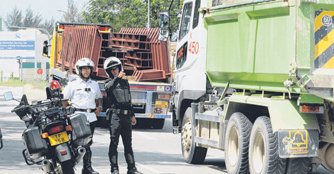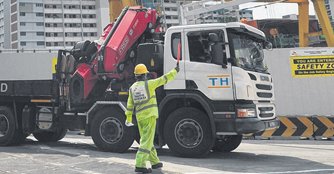Laser sensors to detect overloaded vehicles
15 Sep 2018|1,860 views
The Land Transport Authority (LTA) is turning to new technology to help in the long-running battle against overloaded vehicles. Working with ST Electronics (Info-Comm Systems), the authority is trialling a system to detect overloaded vehicles on the road by weighing them while in motion.

"The system will collect data over a period of six to nine months for analysis. At the end of the trial, LTA will assess if the system is effective and can be used to complement existing enforcement efforts."
The trial equipment comprises laser sensors and a video camera, which are connected wirelessly to sensors embedded in the road.
"When the laser sensors detect the presence of a passing vehicle, it will trigger the sensors (in the road) to weigh and compute the passing vehicle's overall weight," the spokesman said.
Kim Ee Logistics Finance Manager Nancy Tan said, "I think they will come up with all means to discourage overloading. For us, we've been keeping to the correct weights because you can sometimes be hauled to court for overloading." Mr. Michael Wong, who recently retired as General Manager of commercial vehicle agent Triangle Auto, said, "Overall, it is a good move. But it might impact the construction industry."

 Overloaded vehicles can aggravate worn road conditions, and over 60,000 summonses related to overloading have been issued since 2014 LTA said it has issued over 60,000 summonses related to overloaded vehicle offences since 2014, or an average of more than 1,000 a month.
Overloaded vehicles can aggravate worn road conditions, and over 60,000 summonses related to overloading have been issued since 2014 LTA said it has issued over 60,000 summonses related to overloaded vehicle offences since 2014, or an average of more than 1,000 a month.
While noting that road damage occurs with wear and tear, it said overloaded vehicles may aggravate worn road conditions.
This would then 'require more maintenance to ensure the safety of motorists'. Observers have noticed that the left lanes of main roads tend to be more lumpy because they are used most often by heavy vehicles.
Last month, a new Bill was introduced to impose heavier fines for damage caused to road infrastructure. The proposal was to raise the maximum fine for intentionally causing significant damage from the current $10,000 to $100,000.

While noting that road damage occurs with wear and tear, it said overloaded vehicles may aggravate worn road conditions.
This would then 'require more maintenance to ensure the safety of motorists'. Observers have noticed that the left lanes of main roads tend to be more lumpy because they are used most often by heavy vehicles.
Last month, a new Bill was introduced to impose heavier fines for damage caused to road infrastructure. The proposal was to raise the maximum fine for intentionally causing significant damage from the current $10,000 to $100,000.
The Land Transport Authority (LTA) is turning to new technology to help in the long-running battle against overloaded vehicles. Working with ST Electronics (Info-Comm Systems), the authority is trialling a system to detect overloaded vehicles on the road by weighing them while in motion.

"The system will collect data over a period of six to nine months for analysis. At the end of the trial, LTA will assess if the system is effective and can be used to complement existing enforcement efforts."
The trial equipment comprises laser sensors and a video camera, which are connected wirelessly to sensors embedded in the road.
"When the laser sensors detect the presence of a passing vehicle, it will trigger the sensors (in the road) to weigh and compute the passing vehicle's overall weight," the spokesman said.
Kim Ee Logistics Finance Manager Nancy Tan said, "I think they will come up with all means to discourage overloading. For us, we've been keeping to the correct weights because you can sometimes be hauled to court for overloading." Mr. Michael Wong, who recently retired as General Manager of commercial vehicle agent Triangle Auto, said, "Overall, it is a good move. But it might impact the construction industry."

 Overloaded vehicles can aggravate worn road conditions, and over 60,000 summonses related to overloading have been issued since 2014 LTA said it has issued over 60,000 summonses related to overloaded vehicle offences since 2014, or an average of more than 1,000 a month.
Overloaded vehicles can aggravate worn road conditions, and over 60,000 summonses related to overloading have been issued since 2014 LTA said it has issued over 60,000 summonses related to overloaded vehicle offences since 2014, or an average of more than 1,000 a month.
While noting that road damage occurs with wear and tear, it said overloaded vehicles may aggravate worn road conditions.
This would then 'require more maintenance to ensure the safety of motorists'. Observers have noticed that the left lanes of main roads tend to be more lumpy because they are used most often by heavy vehicles.
Last month, a new Bill was introduced to impose heavier fines for damage caused to road infrastructure. The proposal was to raise the maximum fine for intentionally causing significant damage from the current $10,000 to $100,000.

While noting that road damage occurs with wear and tear, it said overloaded vehicles may aggravate worn road conditions.
This would then 'require more maintenance to ensure the safety of motorists'. Observers have noticed that the left lanes of main roads tend to be more lumpy because they are used most often by heavy vehicles.
Last month, a new Bill was introduced to impose heavier fines for damage caused to road infrastructure. The proposal was to raise the maximum fine for intentionally causing significant damage from the current $10,000 to $100,000.
Latest COE Prices
August 2025 | 1st BIDDING
NEXT TENDER: 20 Aug 2025
CAT A$102,009
CAT B$123,498
CAT C$70,001
CAT E$122,334
View Full Results Thank You For Your Subscription.



















